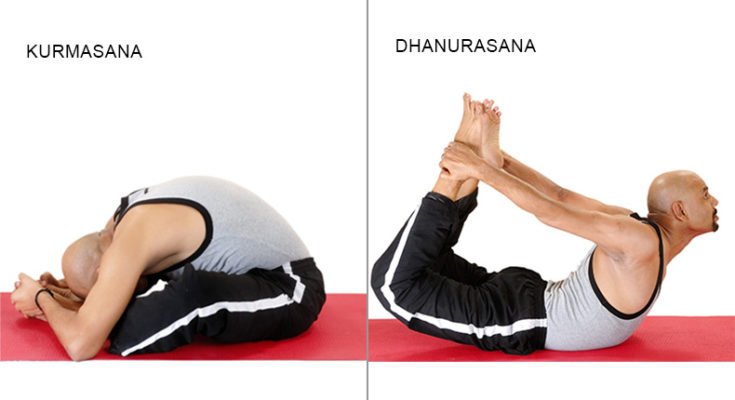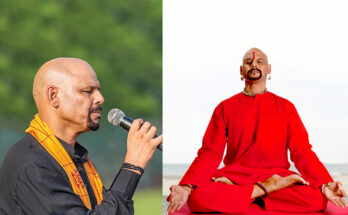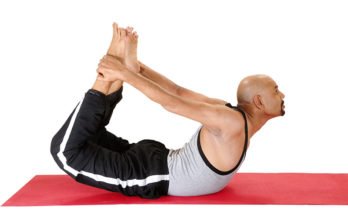Kurmasana (left) & Dhanurasana (right) demonstrated by Yogaguru Suneel Singh. Image Courtesy – Vijay Gautam.
Yoga believes that, first and foremost, one should know one’s own body and its particular requirements. What may be lacking in one individual need not be lacking in another. Each part of the body has its own importance. Navel is a very important part among them. It is considered to be the centre of all the organs of the body. There are 72000 nerves are spread all over the body. It is normally pulled by some tissues, which keep it in its place if for any reason these tissues get pulled then the navel gets displaced.
If the navel is displaced upward, then diseases like constipation, heart palpitation anxiety and stress and if the navel is displaced downward then problems like loose motion, night fall, indigestion, weakness etc. happen. If it is displaced to side then there is shorting stomach aches. And women get various dieses like irregular menstruation, complication of the uterus and leucorrhoea etc.
The best treatment for navel displacement four asanas described in the chapter below should be practised in the same sequence for bringing the dislodged navel at the right place.
1. Kurmasana: The way a tortoise pulls all his organs together with in the body. Similarly this asana is practice that is why it is called korma asana. Fold your feet and keep them apart at the back with toes together. Sit on the ankles spread apart. In this stage the knees will be together and the waist and neck will be straight. Thereafter make fists of both hands with thumbs with in fists will be facing sky. Unite both the elbows together and place them on the navel. Then while exhaling bend as much that the chest touches the arms. The back should not be raised from the heels. (See top-left picture)
Benefits: When tortoise draws its limbs all sides, he withdraws his senses from the object of sense, and then his understanding is well – poised. Its continuous practice is efficacious in many diseases of the stomach, constipation, gastric trouble, and indigestion.
Caution: People who suffer from slipped disc or sciatica, H.B.P. heart problems should not practice this asana.
2. Dhanurasana (Bow pose): Lie flat on your abdomen, with the legs and feet together and the arms and hands beside the body. Bend the knees and bring the heels close to the buttocks. Place the chin on the floor clasp the hand around the ankles. Take a deep breath and raise your head trunk and legs above the round in order to left legs, pull hands and legs in opposite, direction support the entire body on the floor. Hold the position for as long as is comfortable and then slowly relaxing the leg muscles lower the legs, chest and head to the starting position. Do it minimum 3 times daily. (See top-right picture)
Benefits: This asana helps to improve digestion by stimulating gastric secretions. The liver abdominal organ and muscles are massaged. This asana is recommended for the management of diabetes, menstrual disorders and neck pain.
Caution: Patients of colitis, hernia and slipped disc should avoid this asana. Heart patients and hyper tension patients should avoid this asana also.
3. Chakrasana (wheel pose): Lie flat on your back with legs straight on the floor. Bend your legs from the knees and with the help of the hands, bring the heels as close to the hips as possible slowly raise the body and arch the back, allowing the crown on the head to support the weight of the upper body. Putting pressure on the palms, raise your body from the floor arching the back straight then the knees further by moving the trunk towards the head let the hang hand between the straight arms. Hold the final position for as long as is comfortable slowly lower the body so the head rests on the floor and then lower the rest of the body. This is one round repeat 3 times.
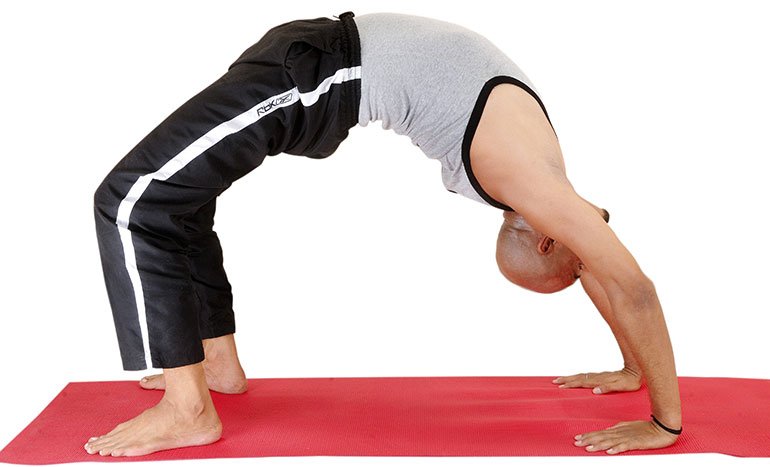
Chakrasana (Wheel pose).
Benefits: This asana tones up the nervous, digestive, respiratory, cardiovascular and glandular systems. This asana dislodged navel at its right position.
Caution: while lifting the body leave the neck loose or else there is fear of a sprain in the neck. People with any illness, during pregnancy and weak wrists should not practice this asana.
4. Matsyasana (Fish Pose): This posture is dedicated to Matsya. ‘Matsya’ means a fish. Lie flat on you back keeping the legs straight on the floor with feet together. Bend the legs and put Padmasana in the lying position. Carefully bend back ward, supporting the body with the arms and elbows. Lift the chest slightly, take the head back and lower the crown of the head to the floor. Hold the big toes and rest the elbows on the floor. Adjust the position of head and hands so that the back is arched to the maximum. Relax the arms and the whole body, allowing the head, buttocks and legs to support the weight of the body close the eyes and breathe slowly and deeply. Stay in this posture as long as you feel comfortable. Return to starting position, reversing the order of movements. Do it one time only.
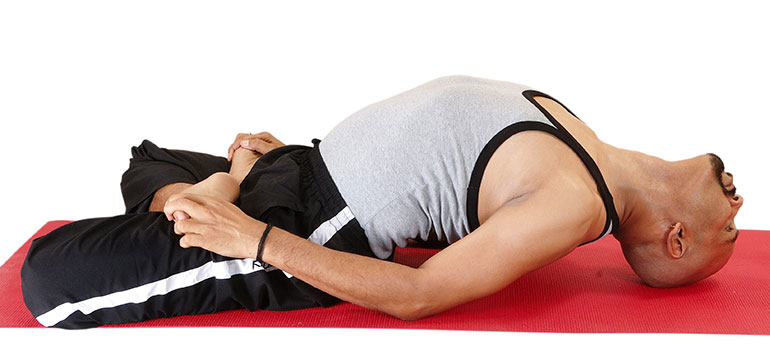
Matsyasana (Fish pose).
Benefits: This asana stretches the intestines and abdominal organs and is useful for all abdominal ailments. The dorsal region is fully extended in this posture and the chest is well expanded. Practice of this asana is very good for asthma and bronchitis as it encourages deep respiration. The asana is very useful for the treatment of constipation, tonsillitis, spondylosis and disorders of reproduction system.
Caution: People who suffer for heart disease, hernia, ulcers, H.B. pressure and pregnant women should not practice this asana.
5. Pawanmuktasana: Lie down on the back with both ankles and toes together. Fold the knee of the left foot and lift it up towards the chest. Then with both hands fold the knee between both elbows push the knee towards the chin and look straight. In this state the other feet will remain straight similarly practice it on the other leg then on both the legs together. Then both legs should be folded between both arms and place the knees on the chin and look straight ahead. Do it three times with each leg.
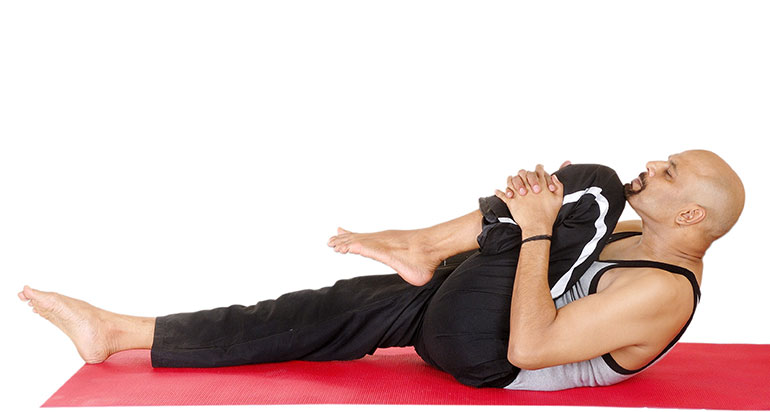
Pawanmuktasana (wheel pose).
Benefits: This asana cures knee pain and arthritis. It massages the digestive organs and is therefore very effective in removing wind and constipation. This asana also massages the pelvic muscles and alleviates impotence, sterility and menstrual problem.

